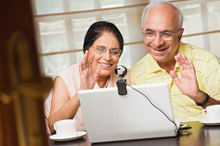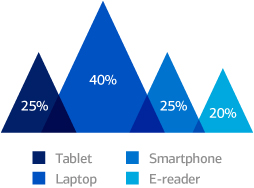
En español | Scientists at the Massachusetts Institute of Technology AgeLab know one thing for sure: Technology doesn’t belong exclusively to the young. In fact, older Americans are among the most enthusiastic and savvy consumers of innovative products.
“Many of them are early adopters,” says Joseph Coughlin, Ph.D., director of the AgeLab, which researches and promotes the development of technology that can help people live better longer. “The rest are quickly following the lead of their peers. Our research shows that the average age of tablet owners is now over 50.”
Got gizmos?
Technology owned by Americans age 65+.

Source: Gallup poll, December, 2013.
Coughlin predicts that, “innovations in technology will radically change the way we live in retirement, making it easier for us to remain independent as we age, care for our parents and stay healthy ourselves.” The most quickly adopted innovations, he observes, “are those that add to our sense of freedom, mobility and individuality. People like technology that allows them to personalize their experience.”
The AgeLab director identifies five technological developments that are already transforming daily life for older Americans:
Home automation
“Computers are rapidly evolving from just another item in your house to being your home’s command center,” Coughlin says. Thanks to mobile technology, you can run your house in Minneapolis from the beach in Florida. Use your tablet or smartphone to raise or lower the heat, water your lawn, or view images from the security camera fixed on your front door. “And if you live hundreds of miles from aging or ailing parents,” Coughlin adds, “home devices and sensors can help you stay connected and make sure they are safe, happy and eating well.”
Wireless medical monitors
“Nothing can replace a face-to-face conversation with your physician,” Coughlin cautions. But mobile, wearable monitors may reduce the time you’ll have to spend on getting checkups. “Monitors that are readily available today can send your latest blood pressure or glucose levels directly to your doctor’s office,” Coughlin says. According to ABI Research, sales of these devices are expected to reach more than $100 million annually by 2016. “Eventually,” Coughlin speculates, “even our toilets may be wired to tattle on us if we haven’t taken our medication or have been snacking on more than our fair share of brownies.”
Dinner by Skype
Retired Americans are especially creative in adapting existing technologies to their own needs, Coughlin observes. Skype, a video conferencing tool, is becoming an easy new way to share a coffee or a meal with old friends, former colleagues, or the kids and grandkids. “We call it having a ‘meal mate,’” Coughlin says. “Dining is really a social event, and now you can do it with someone halfway across the country—or the world.”
It can also be a valuable aid for children concerned about whether their elderly parents are getting the nutrition they need. By virtually sharing a meal with their children, many elderly parents find themselves eating more substantial meals. “Sharing dinner by Skype reminds them that a piece of lettuce and a piece of cheese are not a meal,” Coughlin says.
Safety on wheels
“Such recent innovations as collision warning systems, backup monitoring cameras, enhanced night vision products and hands-off parallel parking systems are already adding comfort and confidence, especially for retired drivers,” Coughlin says. Meanwhile, the AgeLab is using “eye tracking” technology to study what causes drivers to become distracted behind the wheel—research aimed at encouraging the next generation of safer vehicles.
Stealth aging
“While there’s no turning back time,” Coughlin admits, “technology is making it easier to deal discreetly with its effects without losing a step. I call these sneaky adaptations ‘stealth aging.’” Options already available to older people range from things as simple as customizable font size on a tablet reader or larger GPS screens to wireless technology that can help compensate for hearing loss. For example, Coughlin describes a device called miniTek, by Siemens, that enables those who are hard of hearing to automatically and wirelessly sync all of their audio devices (phone, MP3 player, television) to their hearing aids.
As the digital revolution continues to unleash cutting-edge products, retired Americans are sure to be leading, not following. “As early adopters, they’ll be driven by the desire for practical ways to make their lives better,” Coughlin says, “These innovations bring out the child in everyone. After all—technology is cool.”
Learn more and take action
- Today’s new retirement realities require a different way of talking about, planning for and managing your finances to and through retirement. Check out ml.com/retire to help you prepare for the many opportunities and decisions that lie ahead.
- Thinking about retiring? If your 401(k) plan is with Merrill Lynch, one of our Financial Education Specialists can answer your questions about transitioning to retirement without any obligation and at no cost to you. Call toll-free 1.877.637.1786.